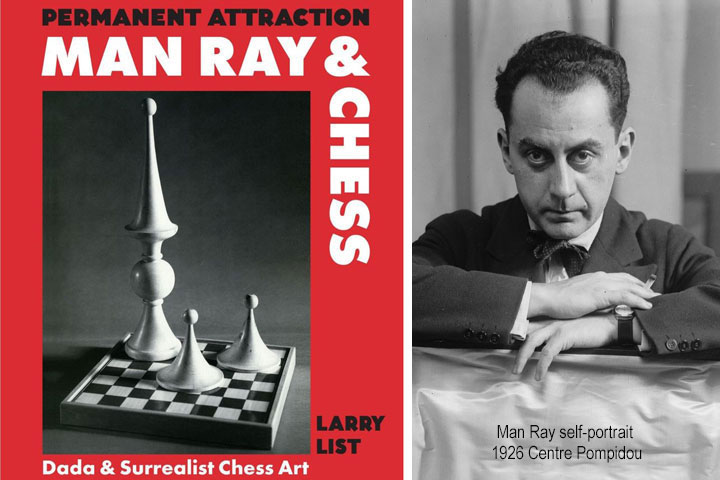Man Ray (born Emmanuel Radnitzky in 1890, Philadelphia – died 1976, Paris) was an American visual artist who became a central figure in the Dada and Surrealist movements, particularly in Paris. He was a painter, photographer, filmmaker, and object maker, renowned for his experimental and avant-garde approach across multiple media.
Man Ray and his closest artist friend Marcel Duchamp shared a lifelong commitment to chess. Duchamp played beautiful games, and Man Ray made beautiful chess sets and chess artwork. He believed that the chess pieces should be as beautiful and modern, or hypermodern, as the chess innovations of the 20th c. grandmasters. The artist saw the chessboard grid as “the original field for clear thinking, imagination, surprise, planning,
and the solid abstract ground to walk on.” The artist used the Knight’s Tour, the concept
of pawn promotion, endgames and many other chess ideas as inspiration for his works.
This is the first book to exhaustively document artist Man Ray’s passion for chess as a “sculpture of many parts.” In the words of Man Ray expert Michael Taylor “it fills the last remaining gap in Man Ray scholarship.”
Authorized by the Man Ray Trust, which was established by the artist’s widow to manage the artist’s estate and legacy, the book has a Foreword by Francis M. Naumann and text by List that draws upon over 15 years of research. Its 256 pages are filled with 350 design drawings, photographs, paintings, sculptures, along with the dozens of chess sets the artist produced from his Brooklyn Boys’ High School days to his final years in Paris.
The book discusses his friendships with World Champion Alexander Alekhine, sculptor Constantin Brancusi, industrial designer Antonin Heythum, and gallerists Marcel Zerbib and Luciano Anselmino. There are chapters about the prolific decade Man Ray spent in L.A. working in seclusion but socializing with the Hollywood Chess Group led by chess master Herman Steiner and with movie star members Lauren Bacall, Humphery Bogart, Charles Boyer, Jose Ferrer and Spencer Tracey.
Man Ray’s chess sets are now as highly sought after as his innovative photographs, having been collected by everyone from the Maharajah of Indore to musicians Igor Stravinsky, Artie Shaw and David Bowie, as well as filmmakers Albert Lewin, Hans Richter and Jim Jarmusch. His chess-themed artworks are in the collections of the Metropolitan Museum of Art, the Museum of Modern Art, the Museum of the Art Institute of Chicago, Pompidou Centre, and numerous other institutions as well as being highly prized by private collectors the world over.
In the words of chess Grandmaster Susan Polgar “Permanent Attraction: Man Ray & Chess does not offer chess tactics or strategy but instead offers chess inspiration by showcasing the complex beauties of bold chess set designs and artworks made by a 20th century master with a lifelong passion for chess. It is a fine addition to our chess libraries.”
Here are a few paintings and objects shown in the book:

The Knight’s Tour. Oil on board, 1946. The Penrose Collection. East Sussex, England. Red-bordered Chessboard Painting, 1946. Oil on board. Minerva Auctions, Rome. Painted on actual wooden chess boards!

Permanent Attraction. 1971 (1948). Joint and Brown Collection, New York. 1962 Bronze Chess Pieces. Dr. George & Vivian Dean Collection, Detroit.

Detail of The Copley Galleries Installation. 1948. Shakespearian Equations paintings, 1947 Aluminum Chess Set & Board (left) and 1945 Wood Chess Set & Board (right).
Previews and reviews of the book
